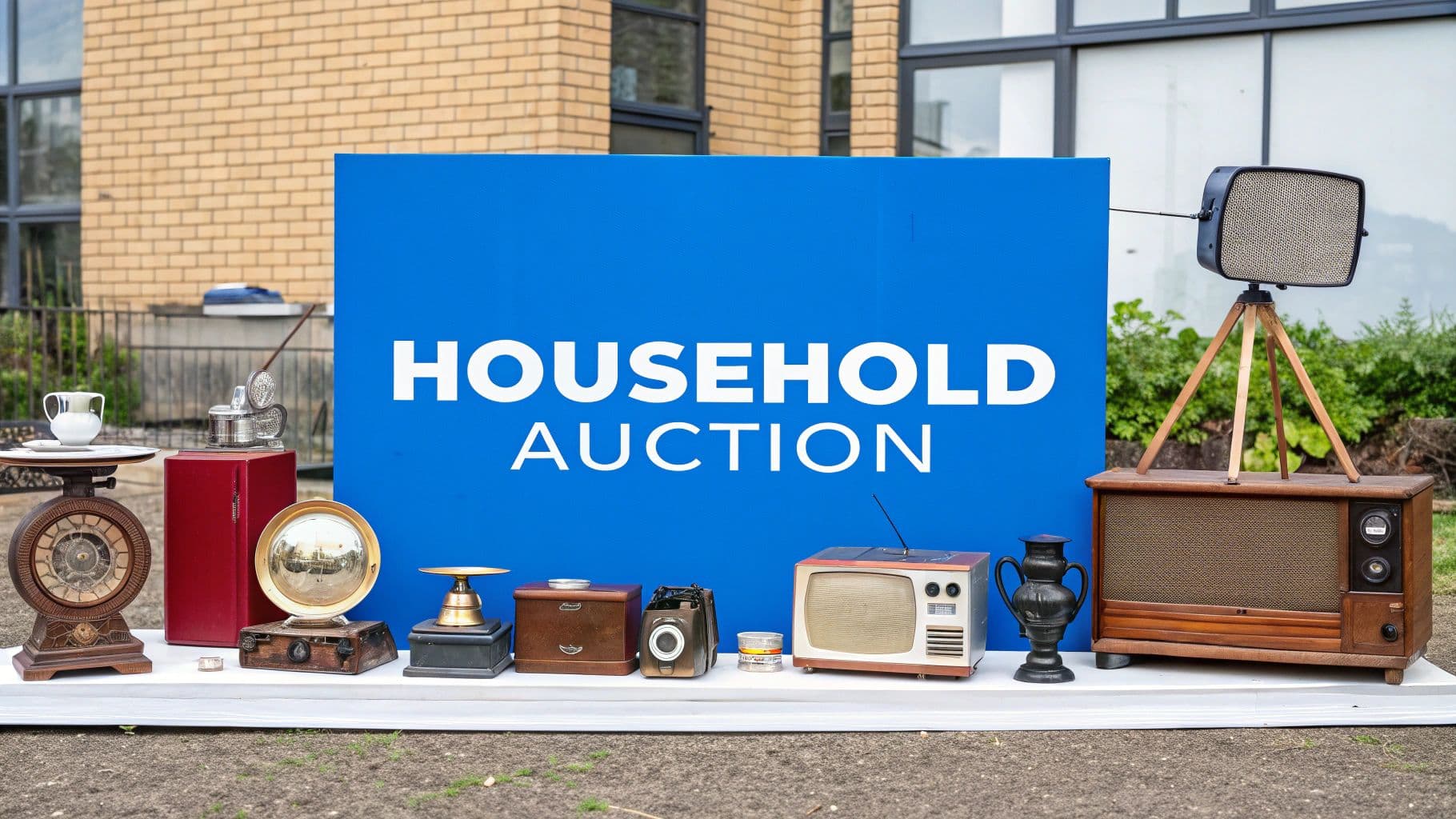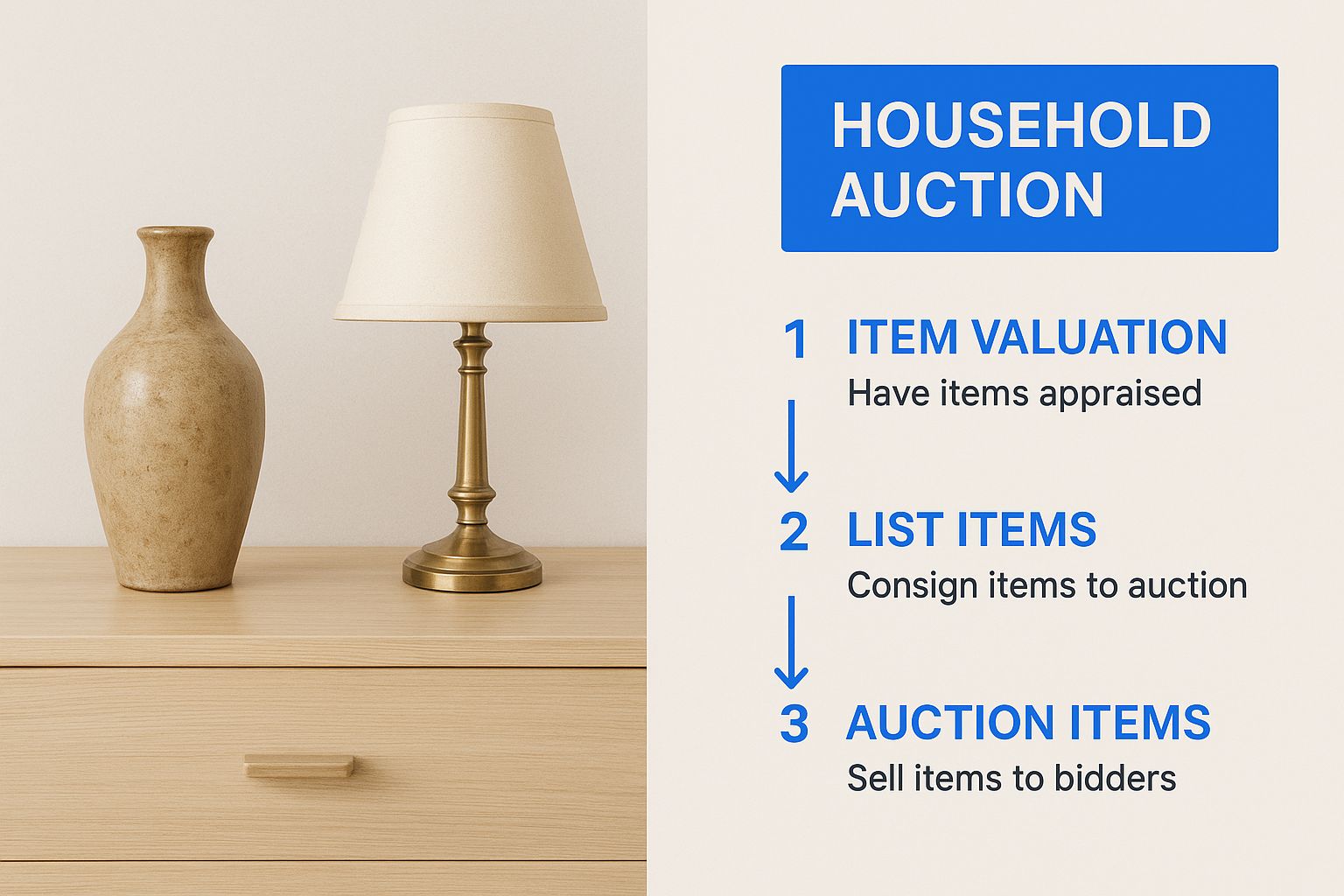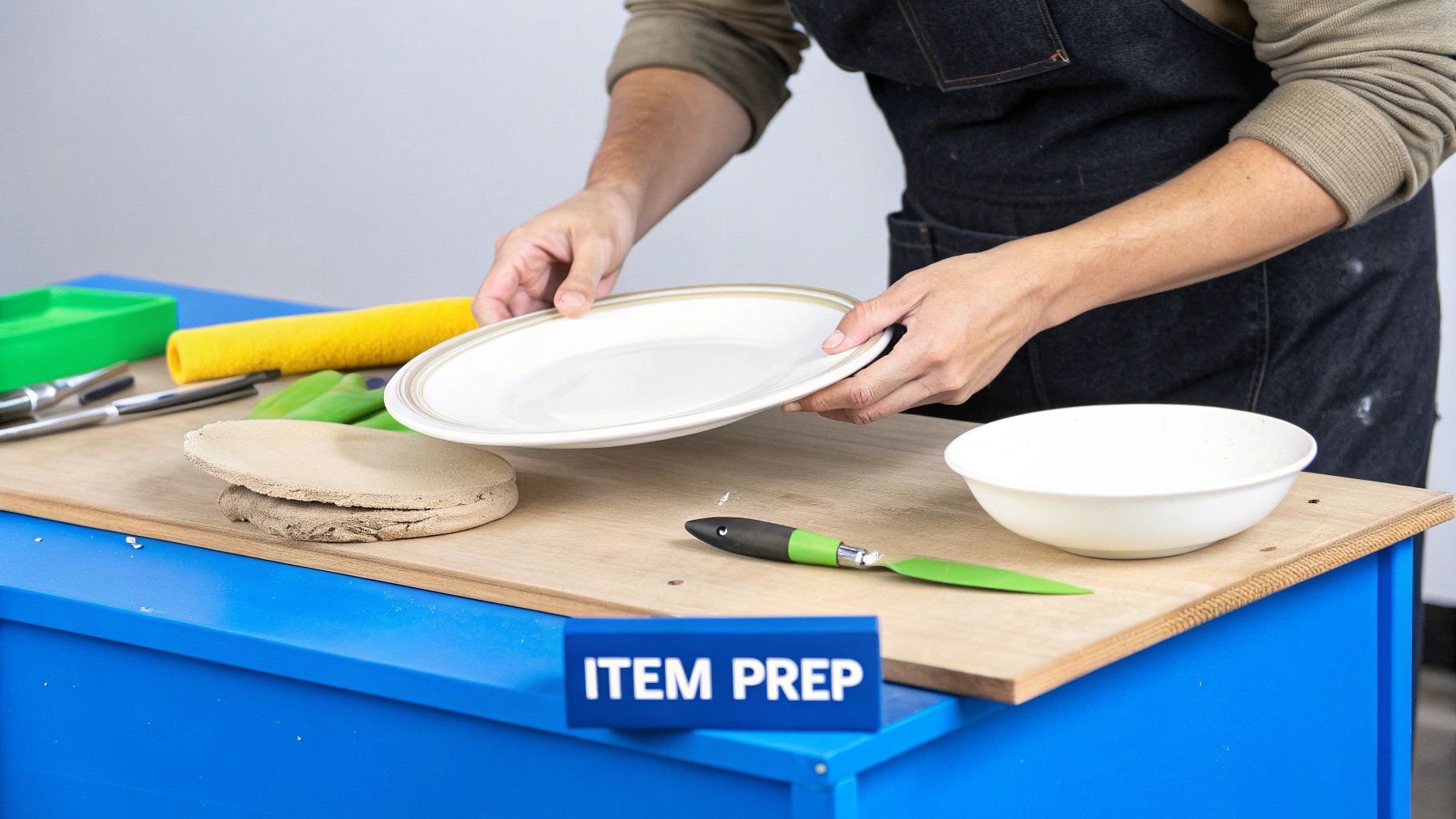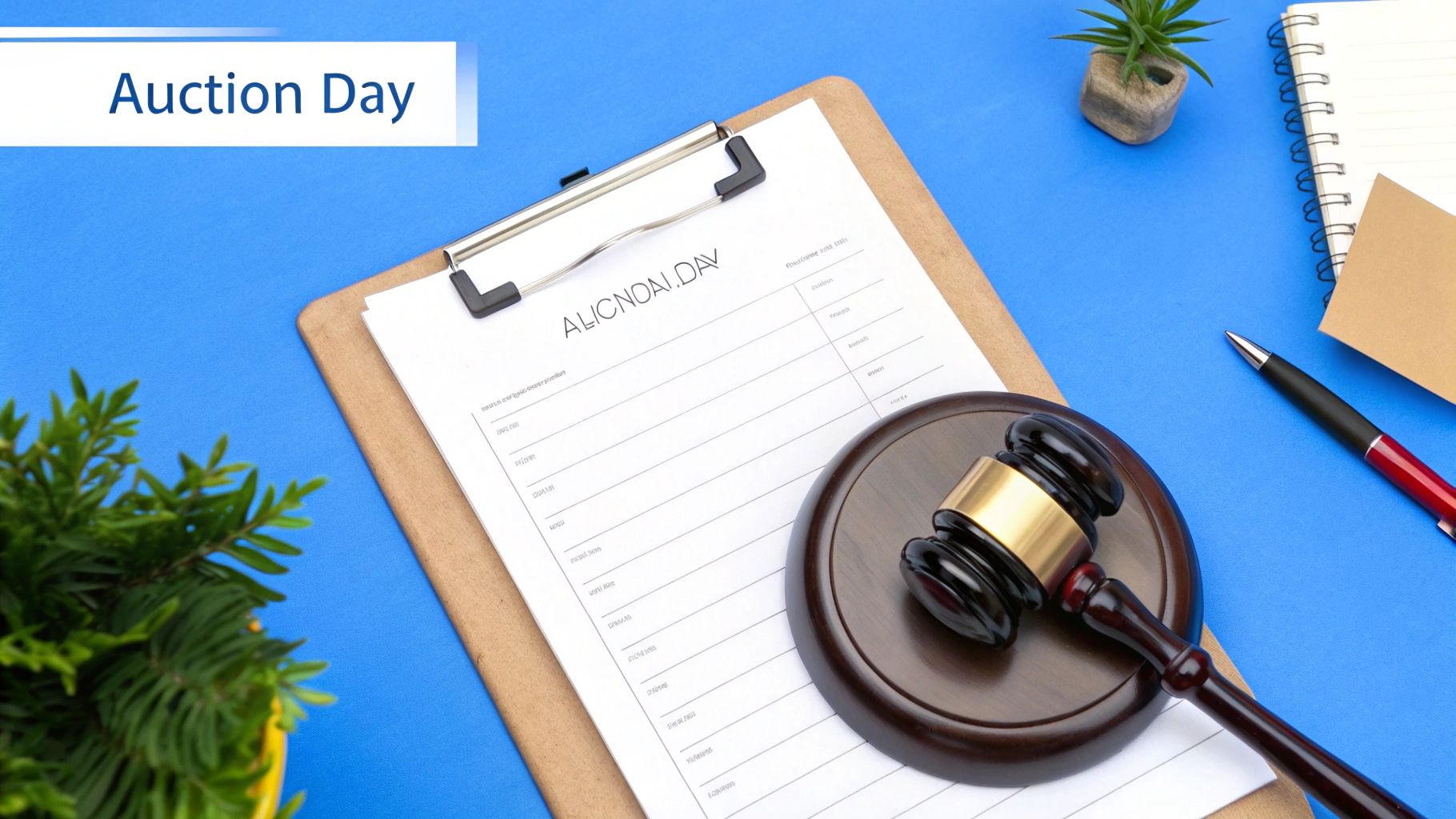Your Guide to a Household Items Auction

Got a house full of stuff you don't need anymore? A household items auction is one of the smartest ways to clear it out and make some serious cash in the process. Whether you're downsizing, helping with an estate, or just tired of the clutter, platforms like DIYAuctions give you a direct line to interested buyers—without the hefty fees you’d pay for traditional auction services.
Why Household Auctions Are So Popular Right Now
The thought of running your own auction can feel like a huge undertaking. I get it. A lot of people look at their old stuff—a vintage lamp, a set of tools, some kitchenware—and think, "Who would possibly want to buy this?"
That's where they're wrong. The truth is, there's a huge and growing market for quality, pre-owned goods.
One person's clutter really is another's treasure. From that mid-century modern armchair in the basement to the box of old video games in the attic, people are actively hunting for unique items with a bit of history. This push for more sustainable, interesting finds is what's making online auctions for everyday household items take off.
The New Breed of Auction Buyer
Forget the stereotype of stuffy auction houses selling priceless art. Today's market is all about accessible, affordable items. In fact, one recent report showed that items priced under $10,000 made up 91% of all art and collectible lots sold globally in the first half of the year. That’s a huge jump from just two years prior.
This isn't just a random trend; it’s a massive shift in what people are buying. You can dig into the evolving market dynamics yourself, but the message is clear: the demand is for exactly the kind of things most of us have sitting around at home.
This quick visual breaks down the journey from spotting potential items to closing the sale.

As you can see, it's often the most common things—lamps, vases, furniture—that are at the heart of today's auction scene.
To give you a clearer picture, here’s a simple table outlining the entire process. Think of it as your roadmap from start to finish.
Your Household Auction Roadmap
This summary breaks down the key phases for running a successful household auction, giving you a clear roadmap of the process.
| Phase | Key Action | Primary Goal |
|---|---|---|
| Preparation | Sort, organize, and identify items for sale. | Create an inventory and set a clear project scope. |
| Cataloging | Take high-quality photos and write compelling descriptions. | Build an attractive auction listing that draws in bidders. |
| Marketing | Launch the auction and share it with your network. | Maximize visibility and attract a large pool of buyers. |
| Execution | Manage the live auction and answer bidder questions. | Encourage competitive bidding and maintain engagement. |
| Completion | Coordinate a single pickup day and process payments. | Ensure a smooth, organized, and profitable final step. |
This structured approach transforms what seems like a massive project into a series of manageable steps.
Don't Let The "What Ifs" Stop You
Platforms like DIYAuctions were built to solve the classic problems. Instead of paying an estate sale company a massive commission, you run the show yourself and keep way more of the profit. It's a game-changer.
Here’s why so many people are choosing this route:
- You're in Control of the Money: You get to set the starting bids and decide on any reserve prices. No more wondering if you got a fair deal.
- It's Surprisingly Simple: The whole process is broken down into easy-to-follow steps. You can catalog everything with just your phone and schedule one pickup day for all the winners. Easy.
- A Built-In Audience: Your sale gets promoted to a big pool of local buyers who are already searching for furniture, antiques, collectibles, and general household goods.
The real magic of a DIY household auction is turning an overwhelming job—like clearing out an entire house—into a structured, profitable, and honestly, kind of fun project. It puts you in charge.
This guide will walk you through everything, step by step. You’ll learn how to spot the hidden gems in your home, create listings that get people bidding, and manage the whole thing like a pro.
Identifying and Valuing Your Hidden Treasures
Let's be honest, this is where the magic really happens. Getting this first part right is what separates a wildly successful household items auction from a disappointing one. It’s how you transform that overwhelming pile of "stuff" into a curated collection of things people will actually fight over.
The best way to start? A simple, room-by-room sweep. Don’t try to tackle the whole house at once—you'll burn out. Pick one area, like the garage or the attic, and make quick decisions. For everything you touch, sort it into one of three piles: Sell, Donate, or Discard. Be firm but realistic. That stack of 20-year-old magazines is probably heading for the discard pile, but that vintage Pyrex dish hiding in the cupboard? That’s a definite keeper for the auction.
Uncovering Overlooked Value
You would be absolutely shocked at what people will buy. Some of the hottest items are things we walk past every single day and have long since dismissed as junk. Your job is to retrain your eyes to spot the potential that others miss.
Here are a few things to keep an eye out for that consistently surprise people:
- Vintage Kitchenware: I'm talking about old CorningWare, Pyrex in those funky patterns, and heavy cast-iron skillets. Collectors go nuts for this stuff.
- Old Electronics: Don't toss that old Nintendo just because it doesn't work. Retro gaming consoles, vintage stereos, and old film cameras can bring in serious cash.
- Unique Decor: Mid-century modern lamps, old metal advertising signs, and quirky pieces of art have a huge following.
- Books and Media: First-edition books, big stacks of vinyl records, and even complete box sets of old VHS tapes can be valuable to the right enthusiast.
The most profitable auctions I've seen almost always have a mix of big-ticket items and dozens of these smaller, overlooked gems. A single vintage cookie jar might not seem like much, but when you have 20 similar finds, the profits really start to stack up.
Estimating Fair Market Value
Okay, you’ve got your "sell" pile. Now comes the most important research you'll do: figuring out what it's all worth. Guessing is the fastest way to leave a ton of money on the table. The trick is to look at what similar items have actually sold for, not the asking price someone is hoping to get.
A great place to start is the "Sold Items" filter on eBay. It gives you real-world data from actual sales, providing a solid baseline for your items. For more specialized things like art or antiques, you might need to dig into collector forums or niche websites. Getting this right is so crucial that we built a whole guide on how to determine fair market value for your auction items.
The Art of Creating Auction Lots
Not everything you own is going to be a showstopper on its own. That's where "lotting"—grouping items into a single bundle—becomes your secret weapon. The goal is to create logical, themed lots that catch a buyer's eye.
For example, instead of trying to sell one spatula for $1, create a "Baker's Dream Lot" with mixing bowls, cookie sheets, a rolling pin, and all those utensils. This strategy does two things brilliantly: it increases the total value of the sale and helps you efficiently clear out all those smaller items, making sure every single thing contributes to your final payout.
Creating Auction Listings That Sell

Let's be honest: in a household items auction, your listing is your most powerful sales tool. It's how you turn an everyday object into something a buyer absolutely has to have. On platforms like DIYAuctions, your listing does all the talking for you, so making a great first impression is everything.
The good news? You don't need a fancy photo studio. Your smartphone is more than enough to capture high-quality photos that get bids. You just need to master a few simple tricks of the trade.
- Lighting is everything. Natural, indirect light is your best friend. Try setting up your items near a large window, but stay out of that harsh, direct sunlight that creates dark, unflattering shadows. If you don't have good natural light, just use a couple of lamps to hit the item from different angles.
- Keep your background clean. A cluttered background is distracting and makes your items look less valuable. A plain wall, a simple piece of white poster board, or even a clean floor can work wonders. The focus should always be on what you're selling.
- Show every angle. Bidders want to see it all—front, back, top, bottom, and any cool details. For something like a piece of furniture, that might mean taking eight to ten different shots. It builds trust and helps people bid with confidence.
Writing Titles That Get Clicks
Your title is the first thing a buyer sees. It needs to be descriptive, but more importantly, it has to be searchable. Put yourself in the buyer's shoes. What words would they type into the search bar? Generic titles like "Old Chair" or "Vintage Lamp" will get lost in the shuffle.
Be specific. Use keywords that highlight the item's best features—think style, material, and brand.
Bad Title: Old Chair Good Title: Mid-Century Modern Teak-Stained Wooden Armchair Great Title: Vintage Danish Mid-Century Modern Teak Wood Armchair with Original Upholstery
See the difference? A great title doesn't just attract more qualified buyers; it immediately signals that you know what you're selling and that you're a trustworthy seller.
Crafting Descriptions That Close the Deal
Once your title and photos have pulled a bidder in, the description is what seals the deal. This is your chance to fill in all the important details and maybe even tell a little story. The key here is total transparency.
- Give the dimensions. Always include the height, width, and depth. This simple step saves everyone a headache and helps bidders know if the item will actually fit in their car or their home.
- Be honest about the condition. Seriously, be brutally honest. Point out every scratch, dent, or chip. It's so much better to over-disclose than to deal with a disappointed buyer later. A close-up photo of any flaws is a pro move.
- Tell the story (if there is one). Was it a family heirloom? Did you find it at a quirky antique shop on vacation? A little bit of history or a personal touch can make an item feel special and much more desirable.
The global auction house market, which is full of household items just like yours, was recently valued at around USD 46.56 billion. Experts predict it will explode to nearly USD 155.29 billion by 2034, all thanks to a growing appetite for unique finds. A well-crafted listing allows you to tap directly into this demand. You can learn more about the growth of the auction house market and see for yourself why now is the perfect time to get started.
Promoting Your Auction to Eager Bidders
Once your auction is live on DIYAuctions, it's time to get the word out. A lot of sellers make the mistake of just posting their sale and hoping for the best. But the real secret to turning a good auction into a great one is proactive, smart marketing. You don’t need a big budget—just a little savvy about where you share your event.
Social media is easily your most powerful, low-cost tool. Start where local communities are already gathered. Think Facebook Marketplace and those "buy and sell" or neighborhood groups that everyone seems to be a part of. Post a handful of your most appealing photos and, most importantly, a direct link to your DIYAuctions sale. The goal is simple: grab their attention and make it ridiculously easy for them to browse everything you’re offering.
Building Buzz Before the Bidding Starts
Don't just post once and call it a day. A little pre-auction hype can make a world of difference. You're essentially creating a movie trailer for your sale.
A fantastic tactic I've seen work time and again is highlighting a "star item" each day in the week leading up to the auction's launch. Pick one unique piece—that mid-century modern armchair or a pristine set of collectible china—and post a killer photo on your social channels. You could write something like, "Previewing another amazing find from our upcoming household items auction! This beauty goes live for bidding on Saturday. See the full catalog here..." It builds real anticipation and keeps your sale top-of-mind.
Pro Tip: Go the extra mile and create a public Facebook Event for your auction. You can invite your friends, share it across local groups, and post daily updates and photo previews all in one spot. It becomes the central hub for your entire promotional push.
Tapping into the Local Network
While a strong online game is essential, you can't afford to ignore old-school local marketing. Some of the most dedicated buyers for household goods, antiques, and collectibles are still plugged into their local scene. In fact, North America and Europe dominate the auction industry, holding over 65% of the market share, partly because of these powerful local networks.
To create a truly effective local buzz, try these proven strategies:
- Print simple flyers: Whip up a basic flyer with a few eye-catching photos, the auction dates, and a QR code linking straight to your DIYAuctions page. Pin them up on community boards at local grocery stores, libraries, and coffee shops.
- Notify the pros: Make a point to personally reach out to the owners of local antique stores, consignment shops, and even flea market vendors. These folks are always on the hunt for new inventory and will genuinely appreciate the heads-up.
This combination of digital promotion and targeted local outreach creates a seriously effective marketing engine for your sale.
To help you decide where to focus your energy, here’s a quick breakdown of the most common channels:
Marketing Channel Effectiveness for Your Auction
A comparison of different marketing channels to help you prioritize your efforts for maximum bidder engagement.
| Channel | Effort Level | Potential Reach | Best For |
|---|---|---|---|
| Facebook Groups/Marketplace | Low | High (Local) | Quickly reaching engaged local buyers with visual items. |
| Flyers & Local Boards | Medium | Medium (Hyper-Local) | Capturing the attention of older demographics and less online-savvy locals. |
| Email to Personal Network | Low | Low (Targeted) | Activating your immediate circle of friends and family who can share. |
| Contacting Local Dealers | Medium | Low (High-Value) | Attracting professional buyers and resellers looking for specific inventory. |
By using a mix of these methods, you cast a wider net and significantly increase the chances of a bidding war.
For an even deeper dive into promotion, check out our comprehensive guide on estate sale marketing techniques. It’s absolutely packed with ideas to help you maximize your reach and drive more bids.
Managing Your Sale and Pickup Logistics

Once your auction is live and the marketing is humming along, you’re in the home stretch. Now it's all about managing the sale itself and, most importantly, orchestrating a smooth pickup process. Getting this part right is the key to a stress-free finish for both you and your buyers.
While the auction is running, make it a point to check for bidder questions on the DIYAuctions platform. People will often ask about an item's condition, specific dimensions, or the pickup logistics. A quick, friendly response doesn't just help that one person—it signals to every potential buyer that you’re a responsive and trustworthy seller, which can really boost bidding confidence.
Streamlining Your Post-Auction Pickup
After the final bids roll in and you have your list of winners, the real logistical work kicks in. I’ve seen it happen time and time again: the single biggest mistake sellers make is announcing a wide-open pickup window and hoping for the best. This almost always leads to chaos, with too many people arriving at once, creating long waits and a frustrating day for everyone involved.
An organized pickup is absolutely non-negotiable. The best way to pull this off is by having buyers schedule specific time slots.
Using a free online scheduling tool like Calendly is a complete game-changer here. You just set your available pickup hours, decide on appointment lengths (say, 15 minutes each), and send the scheduling link to your winning bidders. It automatically prevents double-bookings and gives you a clear, manageable schedule for the day.
This simple, structured approach turns what could be a frantic day into a calm, orderly process. Buyers genuinely appreciate the efficiency, and you stay in complete control of the foot traffic in your home. The principles for a smooth pickup are pretty similar to running a larger event, which we dive into deeper in our guide on how to run an estate sale.
Your Pickup Day Success Checklist
A little bit of prep work goes a long way in making sure your pickup day is seamless. Before your first buyer shows up, run through this quick checklist to ensure a professional and secure handover.
- Group Winning Items Together: Before the big day, take the time to sort and group all items by the winning bidder's name or number. This way, when a buyer arrives, you can just grab their lot without having to hunt for that one last thing.
- Have Packing Supplies Ready: While you should expect buyers to bring their own boxes and wrap, it’s a smart move to have some extras on hand. A small stash of spare boxes, packing tape, or bubble wrap can be a real lifesaver.
- Verify Payment Beforehand: This is critical: never let an item leave your property until you've confirmed payment through your DIYAuctions dashboard. The platform’s secure system is designed to protect you from fraud and ensures every transaction is complete.
- Check IDs for High-Value Items: For your more significant sales, it’s just good practice to ask for a photo ID that matches the name on the invoice. It's a simple step that adds an extra layer of security and confirms you’re handing the item over to the right person.
Following these steps helps you create a fantastic final impression. It encourages buyers to come back for your future auctions and, just as importantly, to leave you those glowing reviews.
Common Questions About Household Auctions
Even with the best plan, questions always come up. It's just part of the process, especially if this is your first household items auction. Getting these common worries sorted out ahead of time is the best way to move forward with confidence and handle anything that comes your way.
Let's dive into some of the most frequent questions we hear from sellers on DIYAuctions.
What Should I Do If My Items Do Not Sell?
This is easily the most common concern, but don't worry—it’s far from a dead end for your items. First off, remember that a low starting bid, even just $1, is a fantastic strategy to get the ball rolling and drum up bidding excitement. It might feel strange, but it’s a proven way to get more eyes on your item and often results in a higher final sale price.
But what if an item still doesn't find a home? You have a few great options:
- Relist It: Sometimes, all it takes is a second chance. You can easily include the item in a future auction. Try bundling it with other similar items or simply taking some fresh photos from a new angle.
- Make a "Second Chance" Offer: Platforms like DIYAuctions have a feature that lets you send a fixed-price offer to bidders who showed interest but didn't win. It's a quick and easy way to make a sale.
- Donate for a Deduction: Having a backup plan to donate unsold goods to a local charity is a smart move. You’ll finally clear out the space, and you can get a tax deduction for your good deed.
The real pro-tip is to decide what you'll do with unsold items before your auction even starts. It completely removes the "what-if" stress and guarantees none of your hard work sorting and cataloging goes to waste.
How Do I Handle Shipping for Out-Of-Town Buyers?
Honestly, the simplest path for most sellers is to set their sale to "Local Pickup Only" in their DIYAuctions settings. This sidesteps all the complexities of packing and postage.
If you’re willing to ship, the key is to be crystal clear from the beginning. Make sure your listing description plainly states that the buyer is responsible for all shipping and handling costs. You can use an online shipping calculator to give interested bidders a realistic estimate. For anything fragile or high-value, it's worth looking into a professional packing service and including that cost in your handling fee. And never, ever ship without tracking and insurance—it protects both you and your buyer.
Is It Better to Sell Items Individually or in Lots?
The right answer here really depends on what you're selling. Your goal is to make every item as appealing as possible to bidders to maximize what you earn.
Think of it like this: high-value, unique, or collectible items deserve their own moment in the spotlight. That signed piece of art, an antique dresser, or a rare power tool should absolutely be sold individually. This allows collectors and serious buyers to focus on that one item and bid it up to its true market value.
On the flip side, everyday items with lower individual values are perfect for bundling into themed lots. Grouping them makes them instantly more attractive. A "Complete Kitchen Gadget Lot" or a "Vintage Board Game Bundle" sounds a lot more interesting and valuable than selling each spatula or game piece for a buck. It also saves you a massive amount of time on listing.